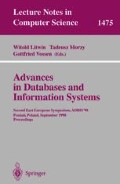Abstract
Schema comparison is essential for integrating different database schemata. Since the semantics of a schema is also represented by its integrity constraints, they must be considered by a correct schema comparison method. Especially the extensional relationships between classes are determined by the relationship between the corresponding integrity constraint sets. In this paper, we work out the relationships between different types of integrity constraints. As a result, we present rule for comparing integrity constraint sets. These rules can be used after a schema conforming step, where naming, type and structural conflicts are solved, to exactly fix the extensional relationship between object classes.
Preview
Unable to display preview. Download preview PDF.
References
C. Batini, M. Lenzerini, S. B. Navathe. A Comparative Analysis of Methodologies for Database Schema Integration. ACM Computing Surveys, 18(4):323–364, 1986.
Y. Dupont, S. Spaccapietra. Schema Integration Engineering in Cooperative Databases Systems. In [8], pp. 759–765.
M. Garcia-Solaco, M. Castellanos, F. Saltor. A Semantic-Discriminated Approach to Integration in Federated Databases. In S. Laufmann, S. Spaccapietra, T. Yokoi (eds.), Proc. CoopIS’95, pp. 19–31, 1995.
S. B. Navathe, R. Elmasri, J. A. Larson. Integrating User Views in Database Design. IEEE Computer, 19(1):50–62, 1986.
I. Schmitt, G. Saake. Schema Integration and View Generation by Resolving Intensional and Extensional Overlappings. In [8], pp. 751–758.
A. P. Sheth, J. A. Larson. Federated Database Systems for Managing Distributed, Heterogeneous, and Autonomous Databases. ACM Computing Surveys, 22(3):183–236, 1990.
S. Spaccapietra, C. Parent, Y. Dupont. Model Independent Assertions for Integration of Heterogeneous Schemas. The VLDB Journal, 1(1):81–126, 1992.
K. Yetongnon, S. Hariri (eds.). Proc. 9th ISCA Int. Conf. on Parallel and Distributed Computing Systems, PDCS’96, International Society for Computers and Their Application, Six Forks Road, Releigh, NC, 1996.
Author information
Authors and Affiliations
Editor information
Rights and permissions
Copyright information
© 1998 Springer-Verlag Berlin Heidelberg
About this paper
Cite this paper
Türker, C., Saake, G. (1998). Deriving relationships between integrity constraints for schema comparison. In: Litwin, W., Morzy, T., Vossen, G. (eds) Advances in Databases and Information Systems. ADBIS 1998. Lecture Notes in Computer Science, vol 1475. Springer, Berlin, Heidelberg. https://doi.org/10.1007/BFb0057732
Download citation
DOI: https://doi.org/10.1007/BFb0057732
Published:
Publisher Name: Springer, Berlin, Heidelberg
Print ISBN: 978-3-540-64924-3
Online ISBN: 978-3-540-68309-4
eBook Packages: Springer Book Archive

